Fast fashion has grabbed the globe by storm in the last few decades. It is a movement that promotes speedy manufacturing, quick turnover, and low prices. Fast fashion businesses such as Zudio, Yousta, and premium brands like Zara, H&M, and Forever 21 have become household names, with items available in every major city across the world.
However, the cost of quick fashion is significantly more than the price tag it touts. After oil and gas, the fashion industry is the world’s second most polluting sector, and fast fashion contributes significantly to this. Fast fashion has been popular in India, as it has been all over the world, but it comes with a flip side as well.
Here’s the dark side of your fast fashion choices, and its impact on sustainability:
- Overconsumption:
Fast fashion encourages consumers to buy more clothing, often at low prices. This leads to overconsumption, where people purchase items they may only wear a few times before discarding them. This constant cycle of buying and disposing of clothing contributes to excessive waste.
- Environmental Impact:
The fast fashion industry is notorious for its negative environmental impact. It relies on the production of large quantities of clothing made from resource-intensive materials like cotton and synthetic fibers. The production process consumes vast amounts of water, energy, and chemicals, contributing to pollution, water scarcity, and greenhouse gas emissions.
- Low-Quality Materials and Workmanship:
To keep costs down, fast fashion brands often use low-quality materials and manufacturing processes. As a result, many fast fashion items have a short lifespan and quickly deteriorate, leading to more frequent replacements and further waste.
- Exploitative Labour Practices:
The fast fashion industry is criticized for its reliance on low-wage labour in developing countries. Workers in these regions often face poor working conditions, low wages, and long hours. Ethical concerns arise due to these exploitative labour practices.
- Waste Generation:
Fast fashion generates a massive amount of textile waste. Discarded clothing often ends up in landfills or incinerators, contributing to environmental pollution and resource depletion. Only a small percentage of clothing is recycled or repurposed.
- Microfiber Pollution:
Synthetic fabrics used in fast fashion, such as polyester and nylon, shed microfibers when washed. These microfibers can enter waterways and oceans, harming marine life and potentially entering the food chain.
- Shortened Fashion Cycles:
Fast fashion’s emphasis on quick production and turnover of clothing leads to shortened fashion cycles. This constant churn of trends encourages consumers to dispose of perfectly wearable clothing in pursuit of the latest styles.
Sustainability in the fashion industry is an ongoing challenge, but there is a growing awareness of the need for change. Many consumers and brands are making efforts to shift towards more sustainable practices, which can contribute to a more environmentally and socially responsible fashion industry. Here are some strategies and practices to do exactly that:
- Buy Less, Choose Well:
Instead of constantly buying cheap fast fashion items, focus on building a smaller, high-quality wardrobe with versatile pieces that can be mixed and matched. Quality items may cost more upfront, but can save you money in the long run since they last longer.
- Shop Sales and Clearance:
Look for sales, clearance sections, and discount stores that offer sustainable clothing options. Sustainable fashion brands occasionally have sales or offer discounts on their products, making them more affordable.
- Second-hand and Thrift Shopping:
Thrift stores, consignment shops, and online second-hand marketplaces are excellent places to find affordable clothing with a lower environmental impact. You can often find high-quality items at a fraction of their original cost.
- Rent or Swap:
Consider clothing rental services or participate in clothing swaps with friends or through community events. This allows you to wear different styles without accumulating a large wardrobe.
- DIY and Upcycling:
Get creative and learn basic sewing and mending skills to repair or upcycle your clothing. You can give old garments a new life or customise them to your liking.
- Support Sustainable Fast Fashion Brands:
Some brands are making efforts to offer sustainable options at competitive prices. Look for fast fashion brands that have introduced sustainable collections or lines with eco-friendly materials.
- Wait for Sales and Discount Codes:
Many sustainable fashion brands offer sales, especially during seasonal transitions. Subscribe to their newsletters or follow them on social media to be notified of discounts and promotions.
- Invest in Timeless Pieces:
Save up for timeless, versatile pieces that won’t go out of style and can be worn for years. These investments can be cost-effective over time.
- Consider the Total Cost of Ownership:
Instead of solely looking at the initial price, consider the total cost of ownership, including how long the item will last and whether it can be easily repaired or recycled.
- Educate Yourself:
Learn more about sustainable fashion practices and materials so you can make informed choices. Look for certifications like Fair Trade, Global Organic Textile Standard (GOTS), or OEKO-TEX Standard 100 when shopping for sustainable clothing.
- Reduce Washing and Care Properly:
Extend the life of your clothing by washing them less frequently and following care instructions. Overwashing can contribute to faster wear and tear.
- Advocate for Change:
Engage with brands on social media and via customer feedback to encourage them to adopt more sustainable practices and offer affordable sustainable options.
Remember that while sustainable clothing may sometimes have a higher upfront cost, the long-term benefits, both for your wallet and the environment, can be substantial. Making conscious choices about your fashion consumption can lead to a more sustainable and cost-effective wardrobe over time.


